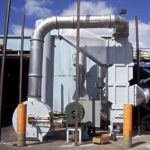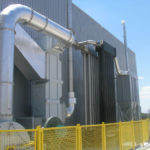Recuperative Thermal Oxidizers
Recuperative Thermal Oxidizers, sometimes referred to as afterburners, utilize direct combustion to convert volatile organic compounds in gaseous effluents to carbon dioxide and water with maximum effectiveness. The heat discharged from the oxidizer can frequently be recovered, reducing the overall cost of afterburner operation. Heat recovery methods may include using heat exchangers to preheat the contaminated gasses prior to entry into the oxidizer, using heat exchangers to preheat combustion air, and using the waste heat for process equipment such as boilers or ovens. EnviroAir custom designs each system, considering such important design principles as proper combustion chamber mixing, sufficiently high temperatures, and adequate time for the combustion process. Additionally, the orientation of the oxidizer can be changed to suit the customer’s space constraints.
EnviroAir Recuperative Thermal Oxidizers Feature:
- Automatic operation – lowers costs
- Solid body construction – for durability
- Fully enclosed heating unit – safer to operate
- Achieves maximum effectiveness – fulfills all EPA regulations for clean air standards
Typical Operation of Recuperative Thermal Oxidizers
Heat Exchanger
The forced draft fan draws in process air and discharges it to the heat exchanger. The process air is preheated in the heat exchanger to raise the temperature closer to the required destruction temperature. The thermal oxidizer then continues heating the process air to the design set point temperature utilizing the burner.
Recuperative thermal oxidizer used in VOC destruction.
Turbulence is created as the air passes by the burner and into the combustion chamber to ensure proper mixing. The combustion chamber is sized to provide the residence time required to destroy the hydrocarbons in the air. The clean hot air then passes back through the heat exchanger to preheat the incoming air. The clean air then leaves the heat exchanger and flows up the stack to atmosphere.

